masonry exoskeleton
Exoskeletons are making their way into the construction industry as a new way to increase worker safety, boost productivity and create a more efficient work environment.
By performing tasks ranging from screwing car bolts overhead in a factory to drilling into walls while holding up heavy equipment, these futuristic machines aim to reduce accumulated strain from prolonged, repetitive tasks throughout the workday. To achieve this, these tools provide added support for a worker’s back, legs, hands or any area most affected by prolonged strain.
Read on to discover the most common types of construction exoskeletons and learn how they are improving both safety and productivity in the industry.
What Are Exoskeletons in Construction?
Sometimes referred to as exosuits, exoskeletons are wearable machines suited with motorized joints that provide lift support, weight dispersion, posture correction and other capabilities to minimize strain and injury. These machines are mainly used for physical rehabilitation but are increasingly used by workers in construction and manufacturing.
Exoskeletons work in various ways depending on the part of the body they’re outfitted for and how they’re powered. Some models shift weight from one part of the body to other areas to reduce continuous strain and increase endurance, while others use grasping tools to enhance a user’s strength. The process to accomplish this varies between the different types of exoskeletons.
Types of Construction Exoskeletons
Depending on the manufacturer, exoskeletons can be purely mechanical or operate with a mix of mechanics and electricity. Frames can be comprised of hard materials like metal or soft materials like cloth and textiles, depending on the suit and its function.
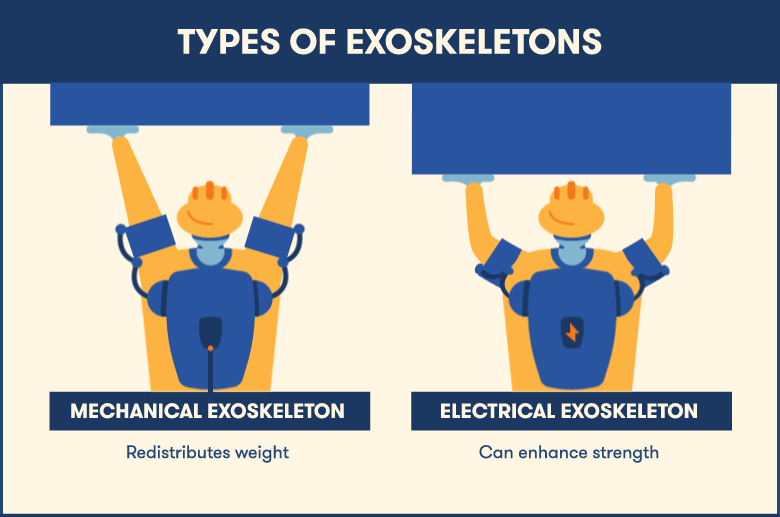
Mechanical
Mechanical exoskeletons use no electricity. Users enjoy longevity in the field since these tools don’t need recharging or an additional power source. Most mechanical exoskeletons take weight from a specific area of the body (like the arms and shoulders) and redistribute it to another (like the core and waist) to reduce strain and fatigue.
Partial or Fully Electric
Partial or fully electric exoskeletons are typically more powerful than mechanical exoskeletons and handle more weight. They can target more specific areas and increase pressure and strength where needed. They do require a power source and time to recharge between uses, however, so they may slow down work if they run out of power unexpectedly.
Construction Exoskeleton Products
There are several types of exoskeleton products that specifically assist construction workers. We’ve classified these suits based on the area of the body they support. Read our list below to learn all about the benefits of varying construction exoskeleton types.
Ironhand: Power Gloves
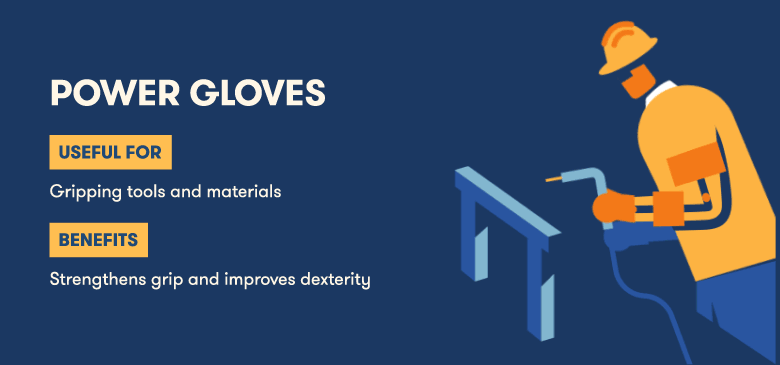
Power gloves fit around the hand to improve dexterity for those who experience weakness or other issues with grasping tools and materials. The improved grip is helpful when carrying heavy hand tools or picking up objects.
The Ironhand from Bioservo is a soft power glove that detects the user’s natural movement via sensors. The glove senses when the user is about to grip an object and increases power based on the object’s weight. It also collects data to assess gripping situations that pose an ergonomic risk to the user.
Ekso Bionics EVO: Arm and Shoulder Support
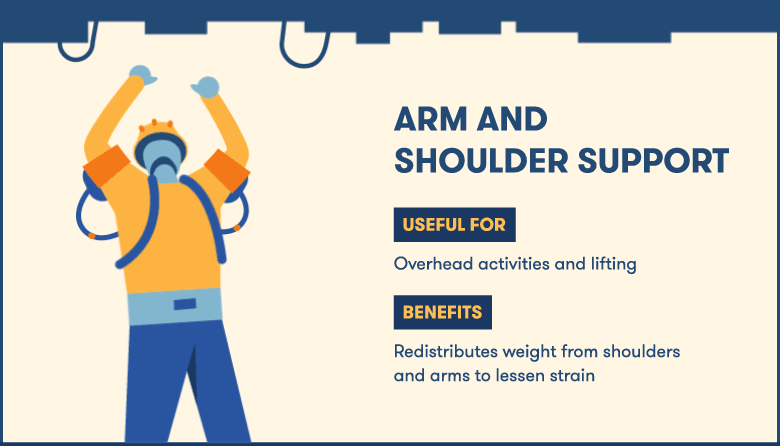
These exosuits support workers who lift heavy tools and materials above the waist. Arm and shoulder support exosuits are ideal for overhead tasks like drilling, cutting and grinding. They support both shoulders and arms to lessen the strain of continuously holding heavy tools for an extended period of time.
Ekso Bionics’ EVO uses springs in both arms to give the user lift assistance, while the Airframe Exoskeleton from Levitate Technologies uses a pulley system to achieve this task, and SuitX’s shoulderX uses springs to support the user. These are all good examples of shoulder support exoskeletons since they’re lightweight, low profile and do not impede mobility.
V3 BackX: Back Support
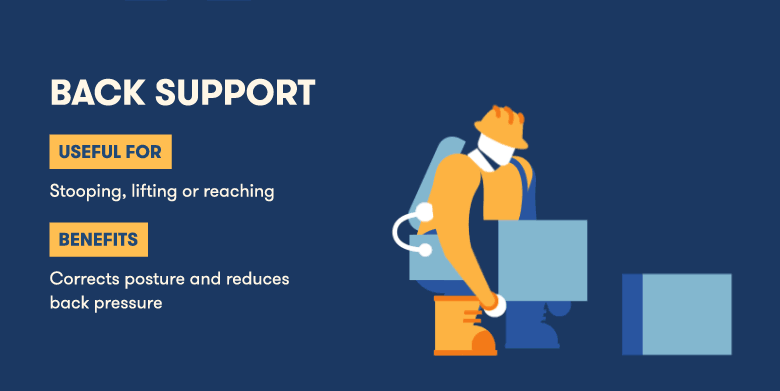
Back support exosuits typically fit around the shoulders, back and waist to reduce stress on the back from lifting heavy objects. Some back support exoskeletons also correct your posture when bending or lifting, depending on the manufacturer.
SuitX’s backX exosuit is designed to reduce stress on the back and spine while stooping, squatting and lifting heavy objects. This device doesn’t need electricity to operate, and it is lightweight and flexible enough to work without hindering a worker’s natural movements.
Chairless Chair 2.0: Standing and Crouching Support
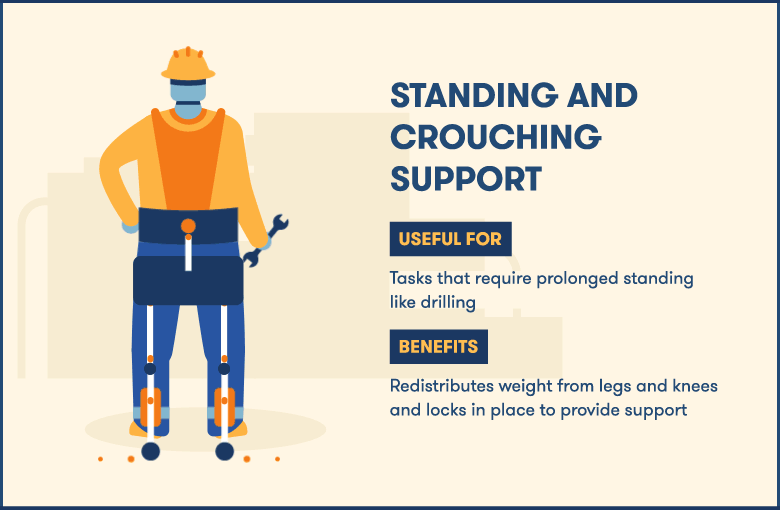
These exosuits lock in place to redistribute weight to the ground and reduce pressure on knees and legs. This minimizes strain on joints and muscles when in a standing or crouching position for a long period of time. These devices also give users the option to “sit” when chairs aren’t available or would otherwise impede safety or productivity in the work zone. This is a helpful feature for construction workers who spend lots of time standing during the workday.
The Chairless Chair 2.0 from Noonee introduces improvements from its previous model, including a decrease in the product’s overall weight and updated materials for comfort and breathability. The legX from suitX is another option that is compatible with tool belts and offers custom work boots for added comfort. Both products recognize when a user is walking, crouching or standing and adjust accordingly.
Guardian XO: Whole-Body Suit
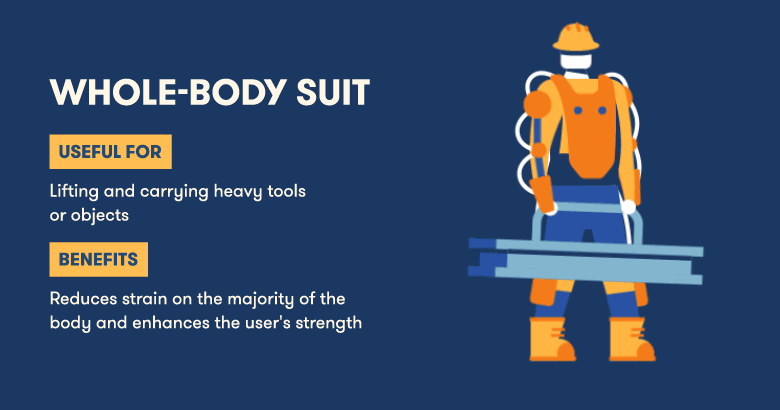
Whole-body exosuits provide support throughout the body to minimize strain, maximize productivity and enhance strength. You can find whole-body suits that are both mechanical and electrical, each coming with its own sets of pros and cons as we’ve mentioned earlier.
Sarcos recently introduced its newest full-body electric suit, the Guardian XO. A single charge can last up to eight hours and requires only 400 watts of power (90% less than similar machines) to operate while walking at a normal pace. Users can also “hot-swap” batteries without losing power and lift objects weighing up to 200 pounds without strain.
Benefits of Construction Exoskeletons
Construction work involves many tasks that can potentially lead to injury. In fact, everyday activities like lifting and carrying heavy objects are the leading cause of strain injuries in construction. Certain construction exoskeletons directly combat these issues. The CDC reported that using an exoskeleton decreased pressure on the spine and decreased fatigue, among other findings. Below are a few benefits of using construction exoskeletons.
- Reduces injury and strain: Exoskeletons distribute weight more evenly and reduce strain on different parts of the body. This can lead to a decreased risk of long-term injuries for construction workers.
- Increases productivity: Workers using construction exoskeletons experience less fatigue and can complete more work than their bodies can usually handle due to the decreased strain.
- Opens employment opportunities: Contractors who are normally limited by age and physical capabilities can endure more strenuous activities.
Construction technology is constantly evolving to make exoskeletons safer and more efficient than ever before. Many exoskeletons today can be personalized to fit a user’s body type and are sleek and lightweight enough to be worn all day.
If you’re interested in introducing exoskeletons to your worksite, you can request a demo from companies that offer product training and on-site demonstrations. This ensures that you know how the product works and what services it offers before purchasing.
Take a look at our infographic below for a summary of the types of construction exoskeletons.

Sources: Constructible | Exoskeleton Report | HG | Ekso Bionics | Levitate | Wired | The Robot Report | Ford | How Stuff Works | Levitate